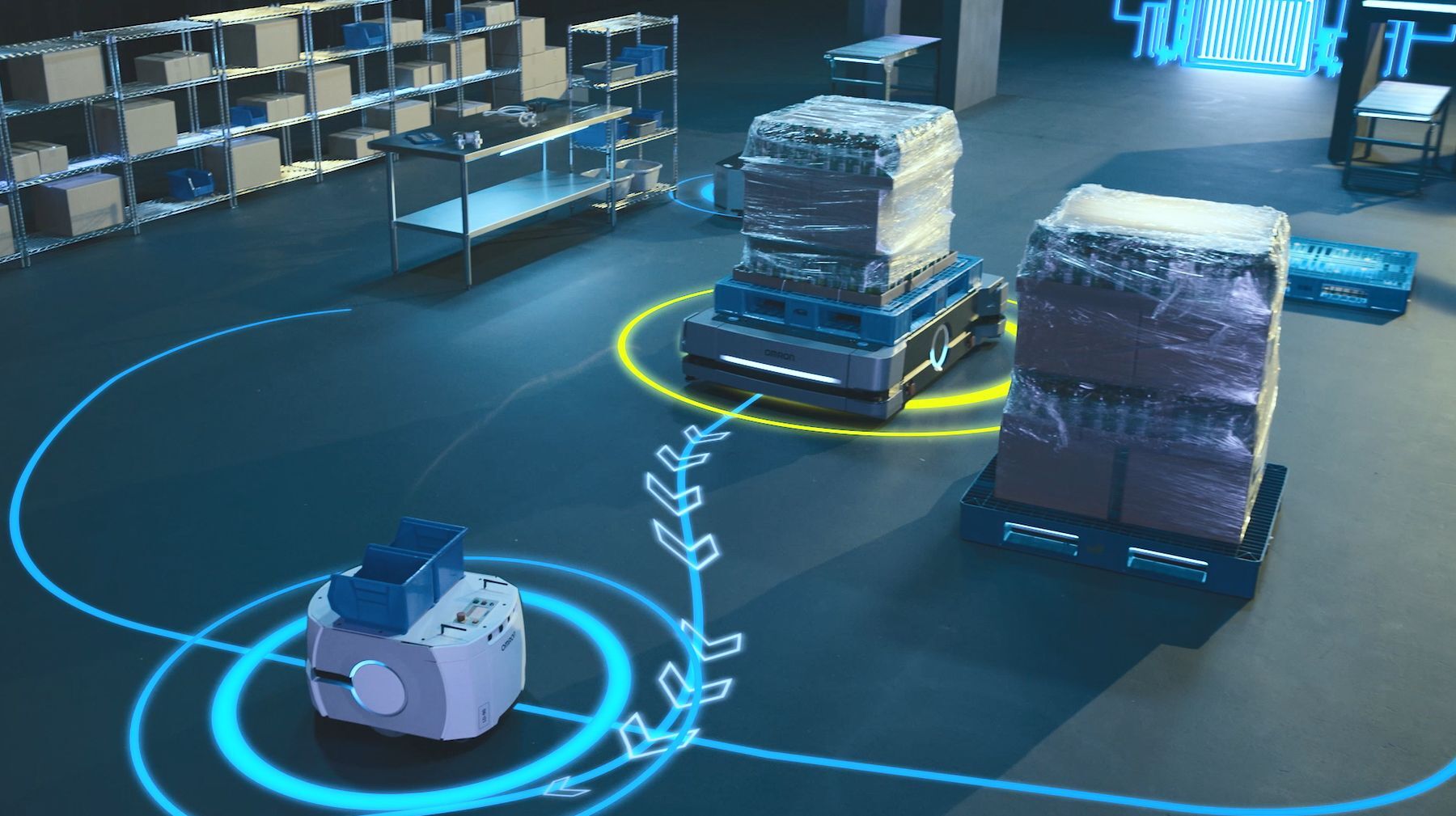OMRON has announced the launch of Fleet Operations Workspace (FLOW) Core 2.1 software that enables short-term introduction of mobile robots. This is achieved through running data analysis, simulation functions and integrated control of multiple robot types.
In recent years, mobile robots have been introduced to automate intralogistics efficiently and safely, with the aim of reducing labour shortages at manufacturing sites and freeing workers from heavy tasks. There is also a growing need for robots to handle different payloads and sizes, from material transport to processing and product shipment. However, companies often face a challenge in finding experts with the right know-how to verify the effectiveness of the system and design before introducing it on the factory floor.
The FLOW Core 2.1 software from OMRON clarifies installation efficiency and issues before the actual installation of mobile robots. Thanks to a fleet simulation function, start-up is quick. It also enables integrated control of multiple types of mobile robots with different payloads, eliminating the complexity of building a system for each type. Even after the system is installed, it is easy to collect travel data and identify bottlenecks, making it possible to visualize the gap between the effects of the system and those targeted at the time of installation, and improve travel efficiency. This shortens the adjustment and verification period of the mobile robot, and allows the user to immediately experience the effects of transport automation, supporting the shift to smart factories in the manufacturing industry. These functions can also be used with mobile robots that have already been installed by updating the existing software to FLOW Core 2.1.
Miguel Garcés, European Mobile Robots Product Marketing Manager at OMRON Europe, comments: “OMRON is continuously driving innovation on the production floor. We are putting the knowledge we have gained from our own factories and customer sites into the development of our mobile robots and fleet management software together. We will continue to contribute to the innovation of manufacturing by freeing people from the simple, monotonous, and hard labour and allowing them to engage in more creative work.”
Main Features of the Newly Expanded Software
1. Travel data visualization and analysis functions (FLOW iQ)
FLOW iQ visualizes information such as heat maps (where autonomous transfer robots are stagnating), path maps (where automated transfer robots are traveling), and robot usage rates (activity analysis) based on travel results. FLOW iQ makes it easy to troubleshoot complex fleets and supports continuous improvement.
2. Fleet simulation function
Simulate the workflow and travel volume of a fleet of autonomous transport robots (the ability to control multiple mobile robots as a swarm) in digital space without actually deploying the robots. Potential bottlenecks can be identified, implementation time can be shortened, and workflows can be optimized.
3. Integrated Fleet Control Function for Multiple Models (MobilePlanner6)
Enables customers to easily build fleets that combine multiple sizes and payloads, and improve manufacturing throughput by controlling them in an integrated manner.
For more information, visit http://industrial.omron.eu/mobilerobots
Images/Captions
Image 1
The FLOW Core 2.1 software from OMRON clarifies installation efficiency and issues before the actual installation of mobile robots

Image 2
FLOW iQ visualizes information such as heat maps (where autonomous transfer robots are stagnating), path maps (where automated transfer robots are traveling), and robot usage rates

About “i-Automation!”
Recently, OMRON has developed a manufacturing innovation concept, called “innovative-Automation” With this concept, OMRON is currently committed to bringing innovation to manufacturing sites through three key innovations, or three “i’s.” Through these innovations in the area of automation, OMRON aims to enable significant productivity improvements in manufacturing sites in order to achieve high-value-added manufacturing. With the first “i,” “integrated” (control evolution), OMRON will seek to advance automated control technology so that virtually any operator, even inexperienced operators, can effortlessly perform work that previously required the expert skills of experienced workers. With the second “i,” “intelligent” (development of intelligence by ICT), OMRON seeks to create constantly evolving equipment and production lines. By adopting a wide range of control devices and artificial intelligence (AI), machines can learn through experience and maintain themselves in optimal condition. For the third “i,” “interactive” (new harmonization between people and machines), OMRON pursues the development of a new harmonious relationship between human operators and machines; as they work together in the same workspace, machines will be able to assist human operators by recognizing human thoughts and behavior in a way that only OMRON, a specialist control equipment manufacturer who knows production floors inside and out, can realize.
About OMRON Corporation
OMRON Corporation is a global leader in the field of automation based on its core technology of “Sensing & Control + Think.” OMRON’s business fields cover a broad spectrum, ranging from industrial automation and electronic components to social infrastructure systems, healthcare, and environmental solutions. Established in 1933, OMRON has about 30,000 employees worldwide, working to provide products and services in around 120 countries and regions. In the field of industrial automation, OMRON supports manufacturing innovation by providing advanced automation technologies and products, as well as through extensive customer support, to help create a better society. For more information, visit OMRON’s website at https://industrial.omron.co.uk



